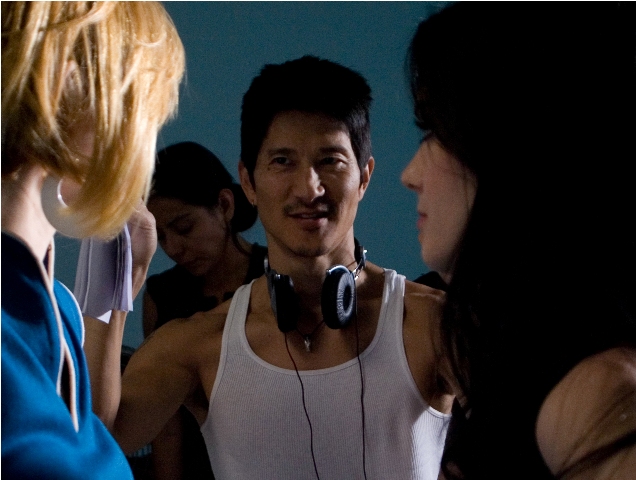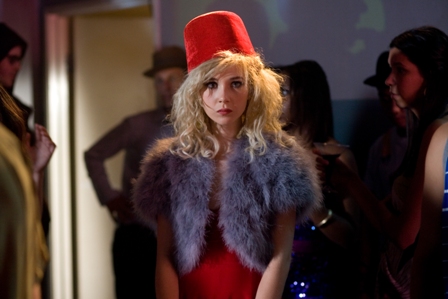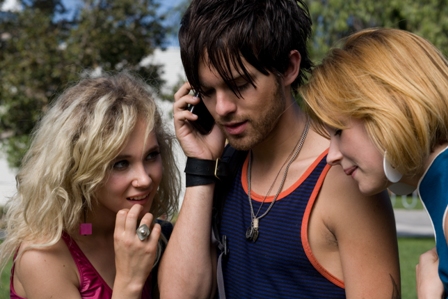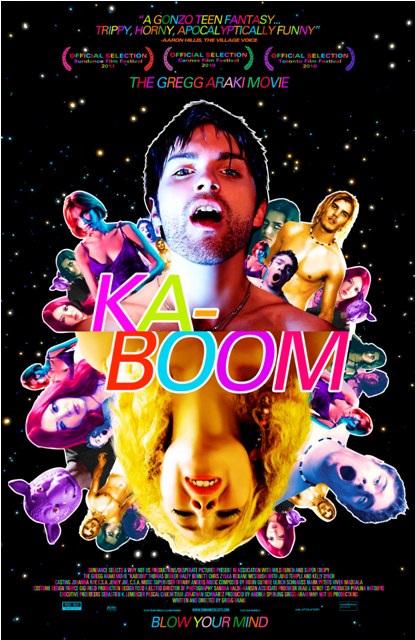CHICAGO – The Steppenwolf Theatre of Chicago continues to provide different viewpoints on the American stage, and their latest “Little Bear Ridge Road” is no exception. Featuring ensemble member Laurie Metcalf, it’s the resonate story of a family at the crossroads. For tickets/details, click LITTLE BEAR.
Interview: Gregg Araki Brings About Optimistic Apocalypse in ‘Kaboom’
CHICAGO – Perhaps no one but Gregg Araki could make a hallucinogenic, doom-laden mystery as playful and curiously optimistic as “Kaboom”. As a leading member of the New Queer Cinema movement, Araki made a series of audacious pictures in the mid-1990s about young characters exploring their sexuality. Three of his pictures became known as the “Teenage Apocalypse Trilogy” starting with 1993’s “Totally F***ed Up”.
After finally receiving mainstream acclaim for his 2004 drama, “Mysterious Skin,” Araki has returned to his thematic roots in “Kaboom,” a film so funny and warmhearted that it suggests the director’s worldview may have brightened over the past decade. The film centers on Smith (Thomas Dekker), a bisexual film major with visions of impending doom. His fantasies routinely collide with reality, as he finds himself attracted to his hopelessly heterosexual roommate, Thor (Chris Zylka), and a flirtatious nymph, London (Juno Temple). Smith’s best friend, Stella (Haley Bennett), has problems of her own when she discovers that her sexy girlfriend has dabbled in witchcraft.
Hollywood Chicago spoke with Araki about his views concerning film school and the Queer New Wave, as well as his unforgettable experience at the 2010 Cannes Film Festival, where “Kaboom” became the first film in history to be awarded the Queer Palm.
HollywoodChicago.com: Many viewers have compared “Kaboom” to “Donnie Darko,” though they seem to have forgotten that you were making apocalyptic films about adolescence long before that film.
Gregg Araki: [laughs] Yeah, people sort of have a cultural amnesia.
HollywoodChicago.com: To what extent was this story autobiographical?
Araki: Obviously, there are huge parts that are fictionalized. [laughs] I mean, it’s really just about the milieu of [college]. I was an undergraduate at film school, a film student very much like Smith. My best friend was an art major at the College of Creative Studies, very much like Stella. My recollection of that period is that there was a lot of hanging out, like we used to hang out in coffee shops all the time. [laughs] So a lot of those details in the movie are very much a part of my experience growing up. But I didn’t have nearly as much sex as these characters. All the murder and mystery and cults are obviously from my imagination.

Gregg Araki on the set of his latest film, Kaboom.
Photo credit: IFC Films
HollywoodChicago.com: Your films often tap into the inherently cinematic nature of young adulthood, externalizing its heightened emotions.
Araki: One of the funnest metaphors for me in the film is the idea that when you’re that age, everything that happens to you is so dramatic and so apocalyptic. If you break up with somebody or fail an exam, your emotions are so big. Everything always feels like the end of the world. I love that scene in the movie where Smith is really questioning if it is the end of the world. Making that emotional state real and part of the story was, for me, one of the funnest parts of the movie.
HollywoodChicago.com: How useful do you personally consider film school?
Araki: I went to film school for seven years. I have an undergraduate degree in film history and film criticism and then I have a master’s degree in production. I absolutely loved it. For me, as a filmmaker, it was really where I grew up, and it obviously had a huge impact on me personally. I think that’s one of the drawbacks of the younger generation of filmmakers. They don’t really know film history very well, so there is sort of, as we were talking about earlier, a cultural amnesia in terms of the fact that they haven’t really studied all the masters, all the great auteurs—Howard Hawkes, Hitchcock, Bergman, Kurosawa. It literally just goes back to, “I saw a Wes Anderson movie two years ago that I liked and I want to make a movie just like it.”
So there’s a certain shallowness. I’m of a different generation. Several of my peers—like Todd Haynes or Gus Van Sant or Rick Linklater or Quentin [Tarantino]—if they didn’t physically go to film school, they basically did their own film school. Quentin has seen virtually every single movie ever made in the history of mankind. That sort of knowledge is really important as a filmmaker, just so you know what’s been done before and you understand that you’re part of a history and tradition. You’re not inventing the wheel. You owe a huge debt to everyone that’s come before you.
 Juno Temple stars in Gregg Araki’s Kaboom. Photo credit: IFC Films |
HollywoodChicago.com: In “Kaboom,” were you attempting to reconnect with elements of your work from the mid-’90s?
Araki: It’s not a conscious attempt but I’m very proud of those movies. It’s more about “The Living End” and also to a certain extent “Totally F***ed Up.” For me, the Queer New Wave was very much a flash point in history. It wasn’t a true New Wave in the sense of the French New Wave or the British New Wave. It wasn’t really any kind of orchestrated movement. It was really just that time in the cultural history when the AIDS crisis was completely out of control and the government did nothing about it. There was so much anger, so much frustration, so much despair in that period that younger people today can’t even really comprehend it. I can’t even really comprehend it and I lived through it. It was interesting for me when we remastered “The Living End” for DVD a few years ago. Seeing that movie again was literally like seeing something that somebody else had made. It was really cool in the sense that it was such an artifact of that time and where my head was at that time.
“Kaboom” is a certain return in the sense that I was trying to get back to a naive and innocent creative place. I really just wanted [the film] to be totally creatively pure and free. I didn’t want to feel the burden of, ‘Oh, this is too weird,’ or, ‘Oh, this isn’t commercial enough,’ or, ‘Oh, this sex scene is going too far,’ or, ‘This might upset some portion of the audience.’ It was really about creating those characters and that story and just letting my imagination run wild and free without that sort of self-censorship. Because it was a smaller movie, my intent was always for it to go to the places other mainstream movies feared to tread. So that’s why, sexually, the movie goes to these forbidden areas. But the story is also so crazy and wild—there’s a character that has supernatural powers. [laughs] The story just gets wilder and wilder and crazier and crazier, and for me, it was such a fun and liberating movie to make. It’s actually one of my favorite movies of mine to watch with an audience, because it takes them on such a crazy ride. There’s a point right around the middle of Reel 4 where you literally can feel the audience going, “Oh my god, what’s happening?”
HollywoodChicago.com: Are audience reactions important to you?
Araki: Yeah, very much so. I’m very much like Smith when he talks about cinema and whether or not it will become extinct. I understand that we live in a new age where everybody watches movies on their iPad because they’re too busy to go to the theater. I hope that the church-like, communal experience of cinema never goes away because there’s something so magical about that, especially for a movie like “Kaboom,” which really takes you to another universe. That doesn’t happen if you’re not in a theater with surround sound, where you’re with a group of people going on a journey. To me, that aspect really suffers when people treat cinema like this thing that they can turn on or off if the phone rings. The movie’s not able to cast that spell. There are certain movies where that doesn’t really matter, but for a movie like “Kaboom,” it’s important that you are immersed in that world.
 Juno Temple, Thomas Dekker and Haley Bennett star in Gregg Araki’s Kaboom. Photo credit: IFC Films |
HollywoodChicago.com: Was it a freeing experience to work within the 2.35:1 aspect ratio for the first time?
Araki: Yes. It was also my first film shot digitally on the Red camera, and I just love the freedom of working totally within the digital world, and what you can do with the colors. It really is, to me, one of my most gorgeous movies ever, and just working on the canvas of the 2.35:1…I have to say that probably the highlight of my entire career was seeing “Kaboom” on that huge, huge screen in the Palais at Cannes, because it’s seriously the most incredible screen I’ve ever seen. It is so huge and so gorgeous, and that alone was a reward for me. [laughs]
I describe it to friends and they really can’t believe it. When we did our tech rehearsal, I took a picture from the stage, looking out into the audience. When I show that picture to my friends they’re like, “Oh my god.” You can’t quite comprehend how big that theater is until you are inside it. I remember literally shaking while walking into it for the first time. It was so overwhelming to be on that screen, and when we had our premiere, it was such an emotional experience. A whole bunch of the cast was there, a whole bunch of the crew was with us, and it was like David and Goliath. We were such a small indie movie screening amongst all the giants. When the last shot in the movie happened, the whole audience started to cheer and we got this crazy standing ovation at the end. It was an incredibly special night. It felt sort of like a dream.
HollywoodChicago.com: A rapturous audience reaction is all the more gratifying, considering the rather troubling nature of your film’s final image.
Araki: John Waters came up to me afterward and said, “That ending was my definition of a feel good ending.” [laughs] So that was validation enough for me.
HollywoodChicago.com: How were you able to elicit such unaffected performances from your young cast?
Araki: This is literally one of the most amazing and incredible casts I’ve ever worked with. They’re all a part of this younger generation of actors who are very eager and excited to take on challenging, unique and different roles. There’s this crop of actors that are very brave and uninterested in doing the same old formulaic crap that’s available to them at this age. So it was just a joy to work with all of them. Given the fact that the movie was shot on a very tight budget and a very tight schedule, there wasn’t a ton of rehearsal time. There also wasn’t a ton of time to do that many takes, and we had a lot of material to shoot in a very short period of time. So I really give credit where credit is due to the actors. People always ask me how I got such a great performance out of Joseph Gordon-Levitt or Anna Faris and my simple answer is, “I cast them.” [laughs] They’re the ones that bring it to set. They’re the ones doing all the hard work and my job is really just to give them a little bit of guidance. They’re the ones who are creating those characters, and the same is true of this cast. They’re all super-talented, super-professional, and always came to the set prepared.

Kaboom opens Feb. 18 at the Music Box and is available through Video On Demand.
Photo credit: IFC Films
HollywoodChicago.com: Do you sense a growing optimism in your work, and if so, is it somewhat connected to the fact that the younger generation’s views of sexuality have become more liberated?
Wiseau: Yes, on both counts. I’m a much different person than I was when I made “The Living End” and “The Doom Generation.” I’m older, hopefully wiser and much more centered than I was in those days. I always describe “Doom Generation” as my Nine Inch Nails movie. I was very angst ridden and very angry and kind of confused. As I’ve gotten older, I really feel like I’ve found my place in the world and that has centered me. The movie that’s tonally closest to “Kaboom” is actually “Smiley Face,” which is my brightest, poppiest movie and that sensibility certainly was infused in “Kaboom.” I’ve always envisioned “Kaboom” as a dark, apocalyptic epic, but there’s a cheerfulness to it and a certain pop sensibility that makes it fun. It’s really one of my funnest movies, with sort of a weird contradiction at its center.
I remember when “Doom Generation” premiered at Sundance. When the audience left the theater, they literally walked out numb and shell-shocked. After the premiere of “Kaboom” at Cannes, the audience was energized and ready to party. We had this crazy party that night and the whole audience was buzzing. There was just so much excitement and a sense of fun about it that I think definitely comes from my more optimistic outlook on the world. I do agree that the younger generation has embraced a certain sexual fluidity. There definitely were kids like that back when I made “Doom Generation” and “Nowhere,” but I feel like it’s become much more common and much, much more widespread. The sexuality that Smith and London discuss in the movie is not about labels and categories and strict definitions. It’s more about experience and growing up and figuring out who you are. I think that’s such an important part of your evolution as a person.
I just feel, at that age, you’re so young, you don’t really know anything about anything. That’s one of the reasons why I wanted to make this movie. It’s really about that time in your life where everything is a question mark. You’re a total unwritten book in terms of what your sexuality is, who you’re going to be, what you’re going to do. Your future is totally unknown, and when you’re living through it, it’s very intimidating and confusing and kind of scary. But looking back on it through this prism of middle age, it’s really some of the best years of your life. The adventures that you have and the crazy things that happen to you and the situations you find yourself in are really an amazing part of growing up.
 | By MATT FAGERHOLM |


